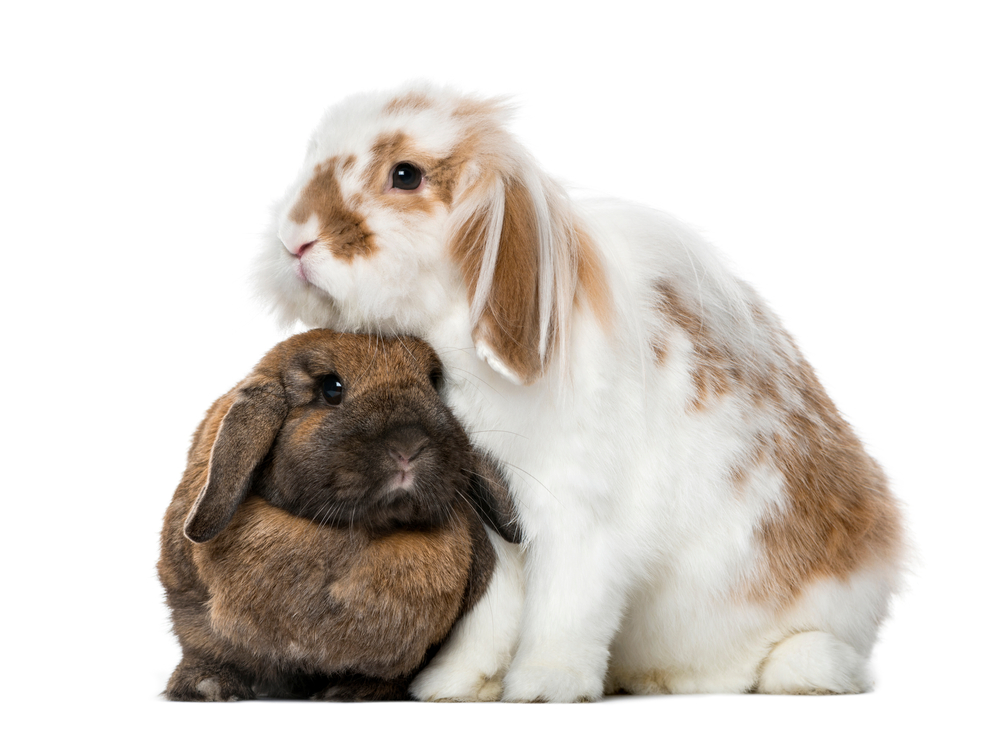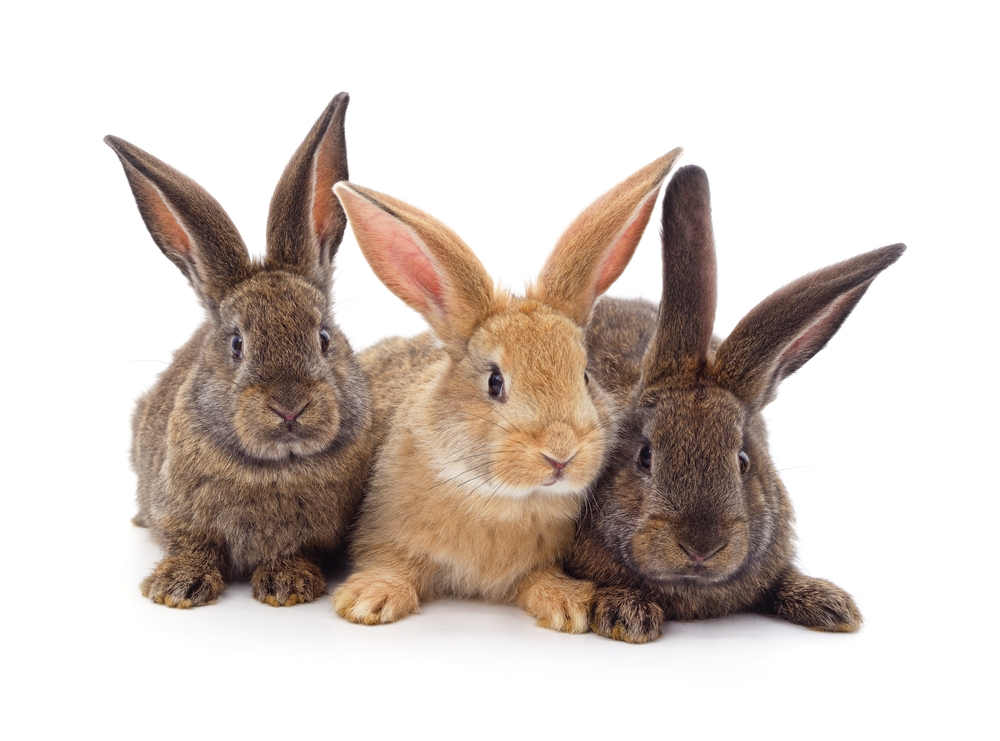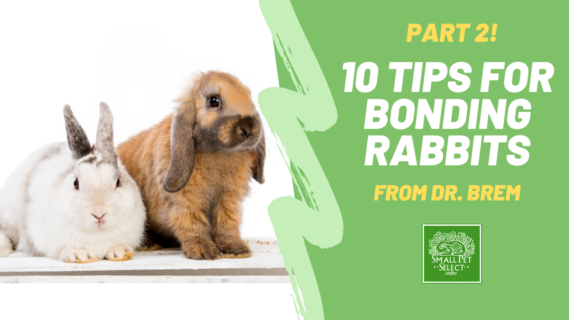If you haven’t already, read Part 1 here for the first 5 tips on rabbit bonding!
Part 2: Tips For Rabbit Bonding
If the rabbits get along for the most part but you were unable to ever get them fully bonded and don’t trust them unsupervised, there is the option of them having their individual areas separate but supervised playtime together.
A lot of these tips work for those supervised playtime sessions and can be used over a long period of time.
6. Force Affection
If there is anything cuter than two rabbits snuggling next to each other, I don’t know what it is. Rabbits enjoy cuddling, and early in the bonding process you can use this instinct to promote positivity.
My bunny intros always start with putting the two (or three) rabbits next to each other in the neutral area, face to face and butt to butt, and petting them. This helps to give them calm and relaxing feelings and helps them associate those feelings with their potential friend.
With the back of one hand, I pet both heads at the same time. Then, if they seem comfortable, I will take one’s ear or cheek and massage the other’s face with it and vice versa, in order to begin to get their scents on each other – and to try to make them think they’re grooming each other. If one lets me, I’ll sometimes rub one’s chin on the other’s head too.
This is a good way to start out with rabbit bonding. After a while, you can allow the rabbits to approach each other from a short distance away. When they get near, start petting them together again. This way they start to realize that coming near each other leads to a reward.
When they are consistently interacting well in this way, you can begin to let them approach from farther away before petting them. Just don’t let them position themselves face to butt yet. It’s too tempting to bite. If one starts to approach the other’s rear end, gently maneuver their heads together. If one does try to nip, gently put them back together and pet them again.
7. Watch Body Language When Rabbit Bonding
Rabbits who have been in a fight are usually much more difficult to bond because of the negative memories of each other. Therefore, it’s important to watch out for body language that is aggressive so that you can hopefully stop a fight before it happens or before one gets worse.
Signs of aggression when rabbit bonding include:
- pulling back their ears
- raising their tails
- growling
- lunging
A rabbit may try a quick lunge and grunt or boxing motion but then stop. If so, you can probably just let it go. Some rabbits are very vocal, and some try to assert themselves in these ways.
If the other rabbit doesn’t seem to care or gets over it, it’s likely not a problem. Likewise, if one rabbit starts to chase the other or nips the other’s butt and the other moves away without further reacting, it’s also likely okay.
If they start circling each other in a “rabbit tornado” or start biting each other, break it up. But don’t be too cautious and not let them get near each other because you’re afraid they’re going to fight.
8. Allow “Neutral” Behavior To Occur
While always on the lookout for aggressive behavior, it’s important to let neutral behavior happen when rabbit bonding. As mentioned in the previous tip, if one rabbit doesn’t seem to mind the other’s actions, then you can probably assume it’s neutral and let it continue. They are establishing roles in their relationship. Just keep an eye on them to make sure it doesn’t become aggressive.

Chasing, nipping, and mounting are some usually neutral behaviors with rabbit bonding. Short chases that don’t turn into circling and in which no one is hurting the other help to work out who is more dominant.
The same with mounting – the mounter is trying to establish dominance. After about ten seconds of either, however, I recommend gently breaking it up, placing them next to each other, and petting them for a minute.
This way the submissive one doesn’t become too anxious and the dominant one doesn’t become too antagonistic. Nipping is a way that rabbits communicate, so a little bit of it with a little pulling of fur is okay as well when rabbit bonding.
Again, pay attention to the temperament and behavior of the other rabbit. And with any of these behaviors, don’t be surprised if the rabbits take turns expressing them.

Bowing or head butting is another behavior in which one rabbit is trying to exert dominance; the rabbit hoping to be dominant is attempting to get the other to groom it. Sometimes this works, but often the one ignores the other in the first steps of rabbit bonding.
Just watch that the bower doesn’t nip the other’s nose. Speaking of ignoring, this is also a neutral behavior. When two rabbits ignore each other, which is common during first meetings, it means that they are getting used to each other. It can actually be a good sign since it means they aren’t being aggressive.
9. End Sessions On A Positive Note
Before the end of a rabbit bonding session, spend a couple minutes petting the rabbits as you did in the beginning. You could also give them some greens. This way, even if something negative happens, they will be more likely to remember the good and to carry that feeling on into the next session.

Also, whenever rabbits do have a negative interaction, lead them to a positive one. For example, if one who tried to get groomed was not successful and nipped the other, gently bring the two together and pet them for a few minutes before letting them explore again.
10. The Last Step: Have A Slumber Party!
Once the rabbits are spending several hours together rabbit bonding every day and not having problems while you are in the next room, they are just about ready to move in together.
Choose a time when you can devote a whole day and night to them. While they are in their neutral area, clean the area where they will be together from now on. This includes pen walls, hidey boxes, bowls, flooring, toys, etc.
Essentially, you want their individual scents gone so that their whole space is now a neutral space. When you are done, allow them to move in. Have another long session bonding rabbits in the new space, in which they can explore their combined area.
Then, sleep near them that night – within hearing distance at least – to ensure they can get along for a long time in a new area overnight.
Enjoy your bonded bunnies!
Copyright 2024 Amy “Brem” Bremers, DVM





